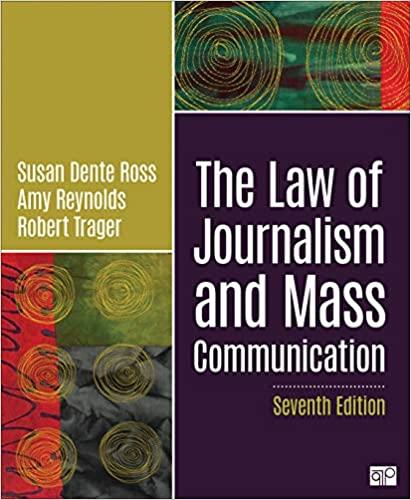Question
Poisonous Pill, Inc. (Poisonous) is a publicly traded corporation of which Wren Waar owned 1 million Class A common shares of the company and 3
Poisonous Pill, Inc. (Poisonous) is a publicly traded corporation of which Wren Waar
owned 1 million Class A common shares of the company and 3 million of the Class B common.
The Class A shares had 10 votes per share while the Class A shares had 1 vote per share. Thus,
Waar while owning only 37% of the shares in the company, held 78% of its voting power and
was able to elect the entire board of directors.
In June, 2021, members of the management of Pills a Poppin, Inc. (Poppin), approached
Waar about buying part of her stake in Poisonous. Waar eventually sold one third of her Class A
shares to Poppin @ $15.00 per share. Waar's remaining shares still controlled Poisonous.
Sometime thereafter, Poppin approached Waar about the possibility of buying out the public
shareholders other than Waar (the unaffiliated shareholders). Negotiations continued and a
proposed merger agreement was reached where Poppin would buy the shares of the unaffiliated
shareholders @ $15 per share in cash. Waar would commit to vote for the merger, would remain
as chair and CEO of the merged company, and would appoint a majority of its board. Waar
would also agree that if the merger did not close, she would not vote for a competing merger for
a period of 1 year after the termination of the Poppin merger agreement.
Poisonous appointed a special committee of outside directors to study the proposed deal
and to make recommendations to the board about whether to accept. The committee also had the
power to negotiate with Poppin concerning changes it desired before making its
recommendation. As a result of those negotiations the proposed agreement was modified to
provide the unaffiliated shareholders $15.25 per share, that there would be a majority of the
minority provision for shareholder approval of the merger, and the period during which Waar
was prohibited from voting for a competing merger was increased to 2 years.
The committee then recommended that Poisonous' board approve the merger. At the
board meeting, Waar urged acceptance and the board complied. When Poisonous sent out its
proxy statement to shareholders for the vote on the merger agreement, it listed the details of the
transaction, including Waar's continued role and controlling shareholder interest but did not
disclose the 2 year prohibition on Waar's voting for a competing merger should the Poppin
merger terminate.
Some of the unaffiliated shareholders of Poisonous bring suit to enjoin the merger. They
claim breach of duties by Waar and the other directors, that the merger was subject to an
impermissible lockup, and Securities Exchange Act violations. Waar and Poisonous respond
with a motion for summary judgment in which they claim that the Poisonous board is entitled to
the benefit of the business judgment rule, that there were no breach
es of duty or federal securities laws, and that Unocal and Revlon and their progeny did not apply.
I need Issues on Appeal section
An effective issue statement includes:
(1) A reference to the relevant law
(2) The legal question
(3) Any legally significant facts
Step by Step Solution
There are 3 Steps involved in it
Step: 1

Get Instant Access to Expert-Tailored Solutions
See step-by-step solutions with expert insights and AI powered tools for academic success
Step: 2

Step: 3

Ace Your Homework with AI
Get the answers you need in no time with our AI-driven, step-by-step assistance
Get Started


